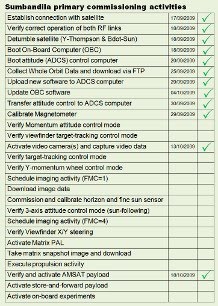The star camera is currently being commissioned. Below is a picture taken by the camera with four stars indicated that were extracted by the on-board algorithm used to detect valid stars.

SunSpace was established in 2000 as a spin-off from Stellenbosch University following the successful launch of SUNSAT by NASA with a Delta-II launch vehicle. During the past decade SunSpace has developed and delivered numerous satellite components, subsystems and two flight model satellite, now operational in space. This blog documents the mission of Sumbandila (funded by the DST), launched on a Soyuz-2.1b on 17 September 2009. SunSpace places a high premium on a strong partnership with the South African Government for supplying the ongoing satellite needs of our government.
03 February 2010
01 February 2010
GPS commissioned
The graph below shows the telemetry from the on-board GPS over three orbits. The bottom trace indicates a valid "lock"; the yellow trace the number of satellites tracked; and the top three traces the X,Y,Z position vectors.
In a perfectly circular orbit, the satellite velocity would be constant. In a near-circular orbit (as is the case with Sumbandila), the velocity fluctuates slightly between a minimum at Apogee and a maximum at Perigee. This effect is clearly visible in the measured velocity data from the GPS (see below). It shows a difference of 30m/s between Apogee and Perigee. Also note the very low level of "noise" on the measurement.
Subscribe to:
Comments (Atom)
Current Keplerian Elements
Last Update: 1 Febr 2010
Element set: 404
Sumbandila 1 35870U 09049F 10032.48635300 .00000433 00000-0 21444-4 0 4040 2 35870 097.3525 084.8560 0011505 166.1189 300.7196 15.22856092 20818




